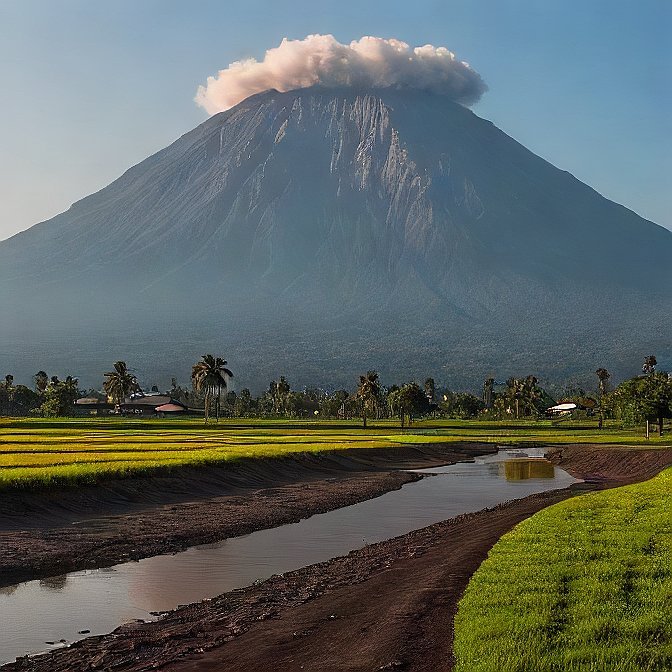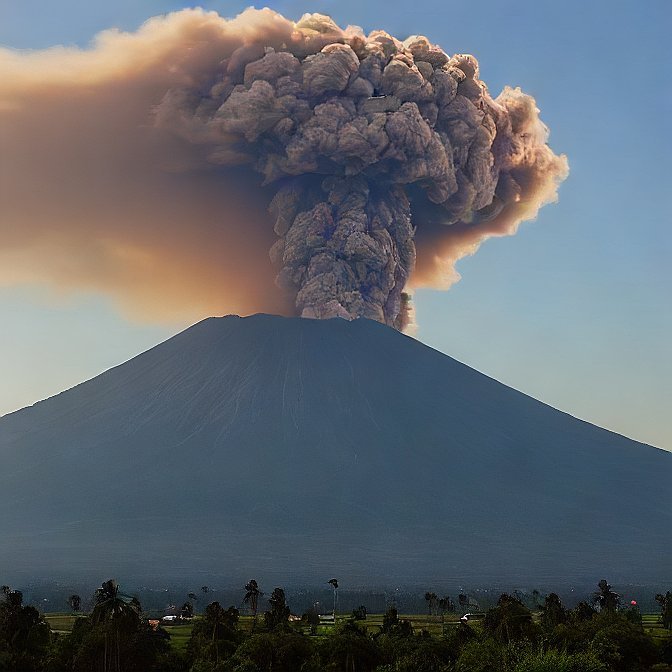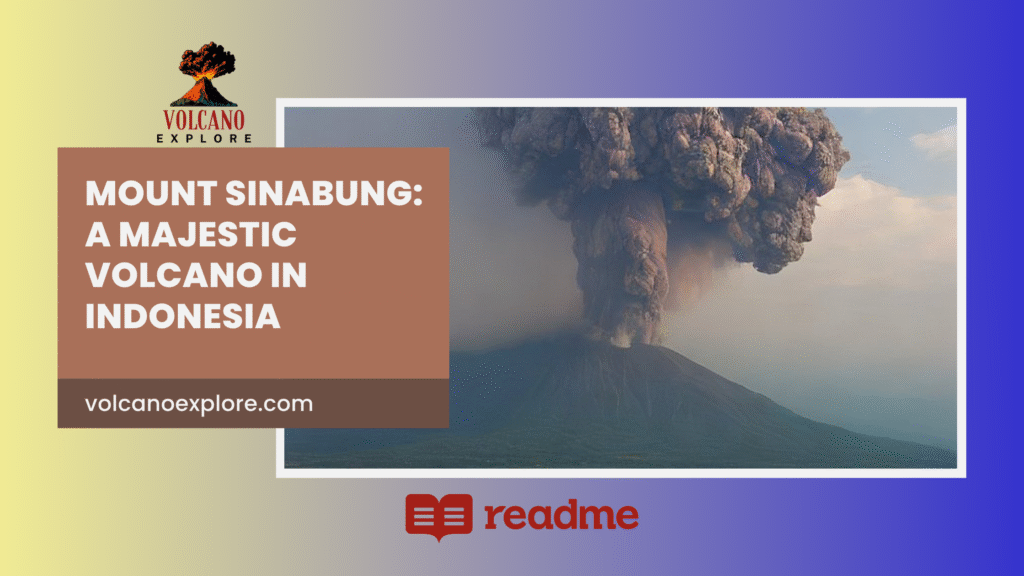Table of Contents
Introduction

Mount Sinabung represents an active volcanic wonder that looms above the North Sumatran terrain within Indonesia. Scientists and other individuals form multiple groups which study Mount Sinabung because of its recurrent violent volcanic activity. Mount Sinabung delivers unique volcanic adventures because of its emerged volcanic activity and active volcanic surface and its mixture of modern and traditional knowledge.
What is Mount Sinabung?
North Sumatra, within Indonesia, hosts Mount Sinabung which rises as an active stratovolcano from the Karo Plateau region. The volcanic mountain functions as a part of Indonesia’s complete volcanic arc network since it exists where the Indo-Australian plate meets the Eurasian plate. The Indonesian volcano Mount Sinabung experienced its most prominent volcanic outbreak in recent years but had earlier staged numerous volcanic activities.
As a volcanic mountain Mount Sinabung displays a traditional stratovolcanic shape yet its eruptions occur explosively. The volcano produces dangerous harmful substances which include ash clouds and both pyroclastic flows and lava flows resulting in threats to the safety of nearby settlements. Scientists operating in the volcanology field continuously examine Mount Sinabung because of its changing geological behavior.
The active volcano exists 66 kilometers (41 miles) from Medan as the capital of North Sumatra province. Scientific teams along with local authorities continuously monitor this area since it exists within the Indonesian Ring of Fire region.
The Eruption History of Mount Sinabung
Archived historical documents prove that Mount Sinabung displayed volcanic activities throughout many previous centuries. In August 2010, the dormant Earth-quiet volcano finally woke up it unleashing a significant volcanic release after remaining inactive for multiple centuries. Mount Sinabung launched an advanced volcanic phase after it ceased its dormant state in August 2010. Multiple volcanic eruptions occurred at Mount Sinabung starting from the year 2010 until the substantial ash cloud-producing eruption in 2013 resulted in broad disruptions throughout the region.
Mount Sinabung produced a series of eruptions after 2010 and its volcanic ash rises between 5 to 10 kilometers (3 to 6 miles) above sea level. A major volcanic event happened in 2016 when volcanic material and ash flows spread through the surrounding towns causing extensive damage. Thousands of residents had to evacuate their homes due to the volcanic event until official authorities enforced an entry ban in the risk zone.
All residents near Mount Sinabung face safety risks because of its ongoing volcanic activity. The advancement of volcanological monitoring technology has helped decrease the quantity of damage caused by volcanism. Multiple strategies for evacuation and volcanic hazards warning programs with safety protocols development for close areas are developed through Indonesian institutional cooperation with geology and volcanology scientists.
The active volcanic eruptions that occur from Mount Sinabung maintain the natural power status of the site even as volcanism remains constant. Scientists receive new insights about geological behaviors with every volcanic eruption which helps advance their research of volcanic activities.
Hiking and Adventure Tourism on Mount Sinabung

The hiking opportunities at Mount Sinabung provide tourists from Indonesia and abroad their most thrilling outdoor experiences. Despite unpredictable eruptions that sometimes block access to the summit area visitors can use available mountaineering paths to reach volcanic scenes which bear the traces of volcanic activity throughout centuries.
The experienced guides who lead hikers behind them know both the paths and the shifting environmental conditions found near the volcano. Walking Mount Sinabung trails lets visitors observe the distinct geological elements of this region through active volcanic craters and volcanic rock formations with vegetation that has naturally adapted to volcanic conditions.
Adventure seekers who trek Mount Sinabung discover breathtaking sights because they journey up through heavily forested areas to see the enormous crater. Tourists walking forward encounter remnants from past volcanic events that include lava stones together with volcanic ash accumulations. From these trails visitors can view the entire Karo Plateau agricultural region which boasts its beautiful valley landscapes.
The essential safety matter remains a critical issue for visitors who decide to pursue activities near Mount Sinabung. Potential travelers must confirm the present volcanic activity threats before they start their mountain climbing journeys because the volcano maintains unpredictable behavior. The public receives continuous volcano updates about safety conditions from local authorities and people must follow these alerts to stay out of danger. The most favorable period for touring Mount Sinabung falls during May to September when volcanic activities maintain greater stability.
Visitors planning to hike Mount Sinabung must grasp the safety hazards the destination presents. Ash clouds which erupt swiftly reduce visibility while polluting the air. Visitors need to obtain the latest eruption predictions and keep following safety directions established by local authorities whenever visiting the area.
Cultural Significance and Local Communities
The people living near Mount Sinabung view the mountain as both a natural masterpiece and a spiritual center. Local Karo people who live in nearby villages maintain intimate ties with Mount Sinabung. The local population understands Mount Sinabung to embody more than its literal shape since it represents natural powers.
The people from surrounding local communities treat Mount Sinabung as a religious phenomenon while connecting it to many traditional myths about the volcano. The spirit of the volcano protects people when they maintain a good relationship with it but puts them in danger when their behavior toward it becomes harmful. Mount Sinabung erupted as an indicator according to spiritual belief that the population needs to show better respect and gratitude to its divine spirit.
Every day activities of the local residents heavily rely on Mount Sinabung as well as its religious value. The volcanic region maintains very rich agricultural lands which enable the planting of rice alongside many different vegetables and numerous kinds of fruits. Physical eruptions from the volcano lead to serious damage to the agricultural areas thus threatening the economic stability of those dependent on farming.
Tourism functions as a crucial economic force within the area since visitors visit to experience hiking along the trails and view eruptions as well as to participate in learning about the distinctive regional culture. Visitors must acknowledge the difficulties that local people face along with the intricate realities of living by an active volcano when they visit this region.
Curious for more? Dive into our other exciting blogs!
The Science Behind Mount Sinabung’s Activity
Since ancient times the scientific field shows intense interest in Mount Sinabung together with its volcanic responses. Geologists together with volcanologists and other scientists monitor Mount Sinabung since it functions as an active stratovolcano to study the volcano’s eruption mechanisms.
Mount Sinabung operates primarily because the neighboring tectonic plates continue their ongoing motion. The gradual force of the Indo-Australian plate beneath the Eurasian plate produces surface magma eruptions at Mount Sinabung throughout its historical eruptions. Studying volcanic behavior allows scientists to predict eruptions and develop safety plans for adjacent communities.
Geological professionals analyze Mount Sinabung by performing various monitoring techniques. The monitoring equipment known as seismographs tracks both earthquake frequencies alongside earthquake magnitudes before volcanic events initiate. Thermal cameras in combination with gas sensors indicate a change in volcanic temperatures and gas releases that signal rising magma approaches and upcoming eruptions. Scientists examine volcanic signals to issue warnings which help manage the hazards from volcanic events.
Scientists are examining the permanent behavior of the volcano to forecast upcoming eruptions in addition to conducting vital monitoring of active volcanic processes. Researchers aim to discover how volcanic processes function by conducting studies in order to design better approaches for safeguarding society.
Tips for Visitors to Mount Sinabung

People experience excellent moments when they visit Mount Sinabung yet they must follow proper preparation with awareness of safety protocols. Planned visitors to Mount Sinabung need these important points as guidelines for their journey to the active volcano region.
What to Pack for Your Trip:
- What to Pack for Your Trip:
- Comfortable hiking shoes or boots.
- A hat, sunscreen, and sunglasses for protection from the sun.
- A digital camera offers an excellent means to photograph the magnificent landscape.
- Sufficient water, snacks, and a first-aid kit.
- The protective piece of clothing will prevent ash from getting into your face during volcanic eruptions.
Safety Measures:
- Before planning a visit always obtain the most recent eruption information from local authorities.
- Relief visitors must stay in marked safe zones as experienced personnel serving as guides provide directions.
- Absolute weather shifts should be monitored because volcanic action controls the local atmospheric conditions.
- When volcanic conditions worsen always pay attention to mandatory evacuation notices.
Conclusion
The majestic Mount Sinabung teaches us about natural forces while displaying their astonishing attractiveness. The volcanic activities introduce serious hazards but simultaneously create scientific prospects and an attractive setting for tourist exploration. At Mount Sinabung visitors can learn about volcanology along with experiencing local communities, their traditions and way of life in the volcanic territory. A proper tourism model functions similarly to nature’s wonders by protecting both environmental aspects as well as local communities living underneath the shadow of these wonders.
For more info about volcanoes: Click Here.
FAQs
Is Mount Sinabung safe to visit?
The volcanic activity of active Mount Sinabung endangers the entire surrounding region. The status of volcanic activity should be checked by visitors besides following safety guidelines enforced by local authorities.
When was the last eruption of Mount Sinabung?
The eruptive activities at Mount Sinabung started again during the year 2020 and continue at present. Travellers should monitor active eruption reports since Mount Sinabung shows intermittent volcanic behavior.
Can you hike to the summit of Mount Sinabung?
You should not hike to the peak of Mount Sinabung since it carries a significant risk of eruption. The region provides selected trails which lead to distinct mountain views along with chances to explore its terrain.





